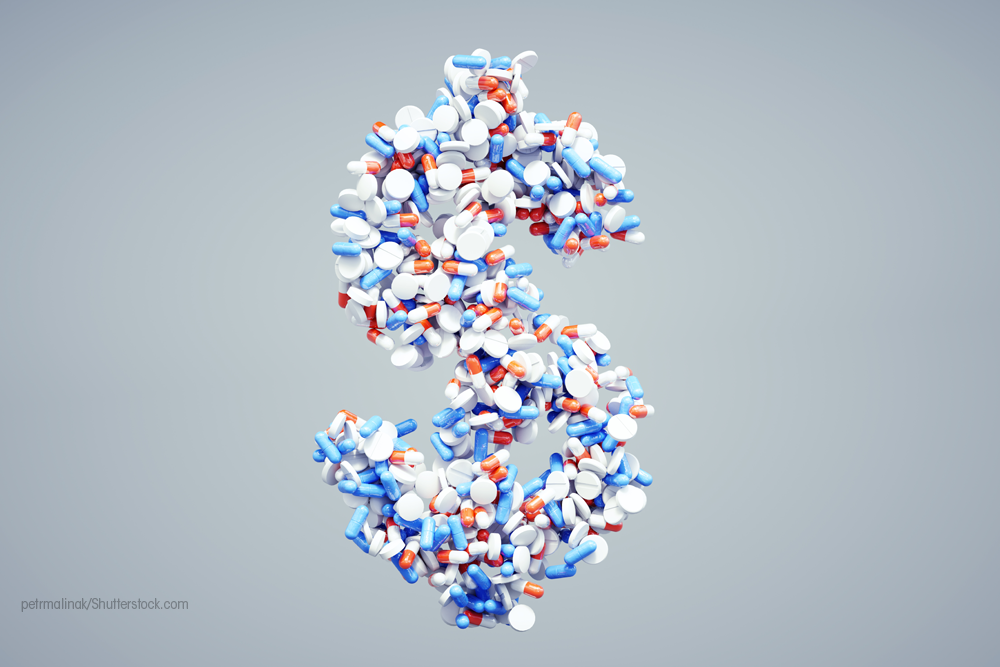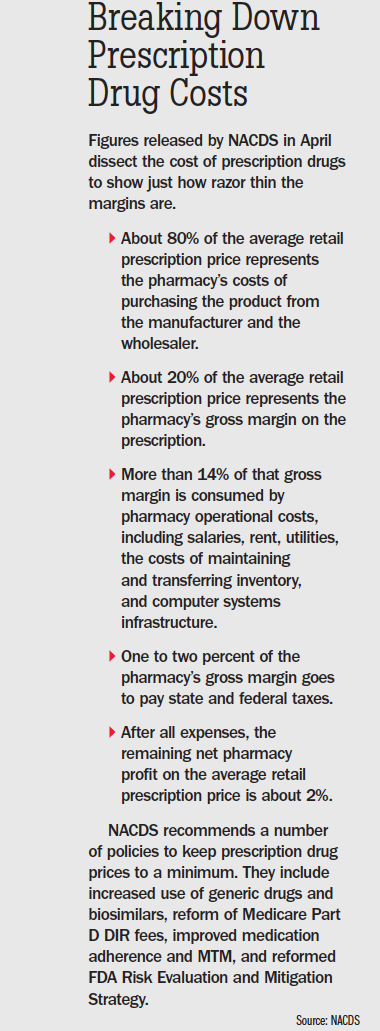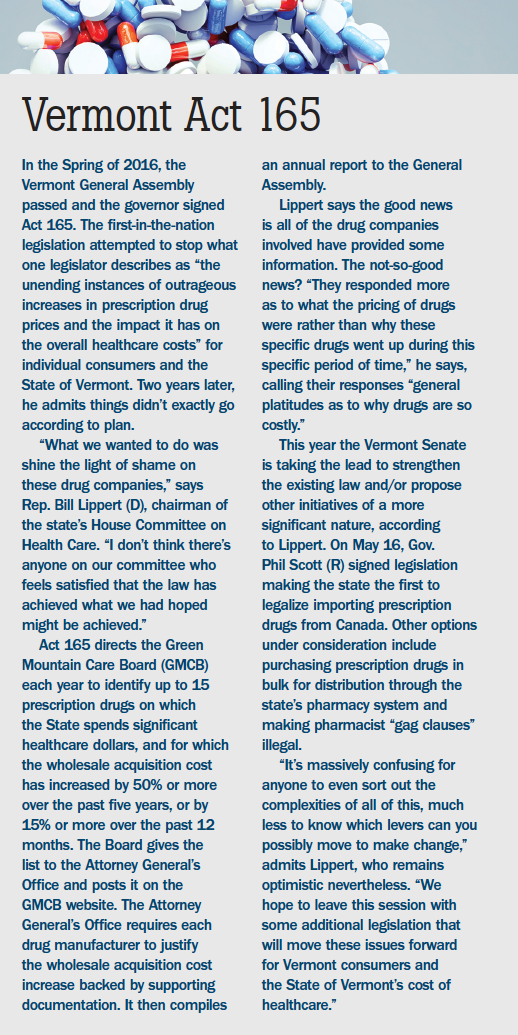How Pharmacies Are Confronting Rising Drug Costs
How to help your patients-and your bottom line.

Click to expand

The relentless rise in prescription drug prices is prompting pharmacists to become more proactive in helping patients save money. Community pharmacists have had a front row seat for the tsunami of prescription price hikes that has been building for decades.
But recent changes have increased awareness and frustration among patients. “What has really caused it to bubble up above the surface are the high deductible plans, and also the changes in insurance plan designs [that] are shifting more of the cost burden to consumers,” says B. Douglas Hoey, RPh, MBA, CEO of the NCPA. “Now, finally, the unveiling is taking place, and consumers are shocked.”
Related article: The Good, The Bad and The Ugly of Drug Prices
Statistics released in mid-April offer some perspective. National health spending in the United States hit a seasonally adjusted annual rate of $3.6 trillion in February 2018, according to the nonprofit healthcare research and consulting organization Altarum. Expenditures for prescription drugs totaled $354 billion-approximately 10% of the healthcare total-and represented an annual growth rate of 4.2%.
Customer Relations Take a Hit
Naturally, pharmacies are bearing the brunt of patient frustrations with high costs. The J.D. Power 2017 U.S. Pharmacy Study reports “notable declines” in overall customer satisfaction that are driven by cost.
On a 1,000-point scale, brick-and-mortar pharmacies fell 27 index points to 789 from 2016, while the in-store experience dropped 14 points to 851.
“Pharmacies have historically earned very high marks for customer satisfaction, so any significant year-over-year decline is cause for closer investigation,” says Rick Johnson, director of the Healthcare Practice at J.D. Power. “Consumer concerns about rising drug prices have likely affected perceptions of the cost for their retail prescriptions. The decrease in satisfaction with cost is the primary drag on overall customer satisfaction, creating a serious challenge for retailers.”
Brian Caswell, RPh, of Wolkar Drugs in Baxter Springs, KS, says price is a top concern for customers at his chain of stores in the southeast corner of the state. Many of them are struggling with escalating copays, lack of insurance, and tremendous increases in the cost of generics, specialty drugs, and biologics.
Related article: Four Ways Trump's Drug Pricing Plan Impacts Pharmacists
When they voice frustrations over high costs, Caswell says having frank conversations helps them see him as a partner, rather than the enemy.
“Most patients understand, and they tell me that they know we’re not getting rich quick,” he explains. “I’ve even sat down and showed them our invoice prices and what the insurance pays. What’s funny is that the conversation goes from, ‘I can’t believe that the prices are this high!’ and, ‘How much are you making?’ to, ‘How can you survive?’”
Click to expand

In neighboring Oklahoma, Justin Wilson, PharmD, co-owns ValuMed Pharmacy in Midwest City and six other independent pharmacies. He says his long-term relationship with patients-some of whom began seeing his pharmacist father in the 1970s- makes it easier to talk dollars and cents with them. He uses various strategies to make their medications more affordable.
“We work with them and their physicians to get them on alternative medications to help reduce those costs. If they’re on Medicare, we work with them on getting manufacturer assistance program cards that help with the copay as well,” he says. “We’re pretty proactive with our patients, and I think that’s helped us to at least be a little more successful at dealing with those concerns.”
Related article: Drugs Cost Billions, Pharmacists Can Help
In addition to responding to patient-frustration associated with rising drug costs, pharmacies are also dealing with the toll that it is taking on their businesses in the form of lower reimbursements.
One National Chain Reacts
The pressure to address soaring prescription drug prices has become a top priority for independent as well as chain pharmacies. In April, CVS Health announced a comprehensive program called CVS Pharmacy Rx Savings Finder to help patients save money. CVS is rolling out the program to CVS Caremark PBM members and expects to gradually expand it this year.
Chief policy and external affairs officer Thomas Moriarty says the new program will help all parties to the transaction manage costs. “CVS Health is giving expanded tools to patients, prescribers, and pharmacists so they can evaluate prescription drug coverage in real-time and identify lower-cost alternatives,” he said when the program was announced. “We are committed to finding the right drug at the lowest possible cost for patients to ensure they are able to access and stay on the medications they need.”
Pharmacists can use the program to determine if the prescribed medication is on the patient’s formulary and is the lowest cost option. They can also learn if lower-cost options with equivalent efficacy of treatment are covered under the patient’s pharmacy benefit, or if the patient may save money by filling a 90-day prescription rather than a 30-day one. If a generic or lower-cost alternative is not available, the program provides other potential savings options for eligible or uninsured patients, where allowed by applicable laws and regulation.
Related article: 10 Pharmacist Suggestions for Trump's Drug Pricing Campaign
The new tool enhances existing savings opportunities that CVS Caremark offers, including preventive drug lists that make medications for many common chronic conditions available at no copay. The PBM also provides realtime, member-specific drug costs and lower-cost alternatives to prescribers through their electronic health record system and to CVS Caremark members through the member portal and app. The company’s point of sale rebate also passes along negotiated rebates on branded drugs directly to patients when they fill their prescriptions.
Walgreens declined to comment specifically on the pricing issue.
Click to expand

Business Implications
In what might be considered a perfect storm, escalating prescription prices are also causing revenue problems for pharmacies, says Stephen Giroux, RPh, owner of seven pharmacies in western New York. “When prices go up, payers-be they health plans or employers or PBMs on behalf of their clients-want a cut,” the NCPA past president explains. “And where do they turn to cut first? The easiest target is our reimbursement.”
Related article: Drug Makers Find New Ways to Thwart Generic Competition
Giroux recalls the controversy involving the 500% price hike for EpiPen that transpired between 2009 and 2016. Mylan’s CEO Heather Bresch testified before the House Oversight and Government Reform Committee in 2016 that Mylan made about $100 profit off each EpiPen two-pack, which had a list price of $608. Giroux ran an analysis at the time and found that his gross profit from EpiPen transactions ranged from losing $5 to making up to $12.
“Think about any industry in the world making a $12 gross margin on a $608 cost item,” he marvels. “That’s a miniscule gross margin, to say nothing of the fact that our cost to dispense with rent, heat, light, and salaries is obviously far greater than that.”
Generic drugs are another area of concern for pharmacists, says Hoey, but for a different reason. As a group, their cost is in decline, but he wonders how long that will last. “Generic Lipitor, generic Zocor, lisinopril, metformin- fantastic drugs, centerpieces of therapy for many disease states-are so inexpensive. We think that generic prices will skyrocket, which we’ve seen previously,” he says.
Zero reimbursements for many generics is common, says Giroux. He recently filled five prescriptions for one patient: omeprazole, lisinopril, metformin, amlodipine, and pravastatin. The total paid for the first four prescriptions was $6.83 in copays and nothing from insurance; the fifth prescription cost the patient nothing out of pocket and insurance paid $7.48. Great for the patient, not so much for his business.
“It’s very typical of what we do every day all day long-not a good long-term scenario,” says Giroux, who adds that 20% of the prescriptions his stores fill yield less than $5 total reimbursement. “Because of some generic price spikes in recent years, we were oftentimes underwater substantially.”
Related article: Why Health Systems Are Making Their Own Generics
DIR fees add fuel to the fi re of declining reimbursements. A recent NCPA survey reveals that an overwhelming majority of independent community pharmacists say retroactive DIR fees undermine patients’ access to prescriptions and hinder their own ability to manage their businesses. Eighty-four percent of respondents say they never know what their final reimbursement will be at the point of sale; 77% report that it could take up to a year before they had that information. “When you see dwindling reimbursements and unnecessary retroactive fees and all sorts of things that are putting pressure on the business side, it’s hard to keep the doors open and continue to provide services to our patients,” Wilson says.
Revenue Boosting Options
Wilson is exploring alternative revenue streams-including chronic care management-and efficiency improvements. “It’s tougher than ever on the financial side. We’re really trying to focus on finding ways to continue to provide a high level of care to our patients,” says Wilson.
He adds that when you see dwindling reimbursements and unnecessary retroactive fees and all sorts of things that are putting pressure on the business side, it’s hard to keep the doors open and continue to provide those services to patients. “We’re working hard, though, and trying to figure out ways to do alternate revenue streams or improve efficiencies and make this model work so that we can continue that one-on-one relationship and ultimately hopefully improve patient care outcomes.”
Alternative Revenue Streams
For some pharmacies, it’s getting harder and harder to make a living just filling prescriptions, and as a result, Wilson says that he is exploring other opportunities. “How can we bring in services that improve the health of our patients and generate revenue outside of being tied to a drug product? Chronic care management is something we’re exploring, collaborating with physicians to help improve patient care outcomes and be able to get paid under Medicare Part B versus Part D.”
Related article: The Winners and Losers of 340B Changes
Wilson says that he’s always tries to make business decisions based on the needs of patients. “I still believe that, but I think it’s getting harder and harder. We’re at a critical point in the reimbursement model that we have right now.” Caswell is expanding over-the-counter medications and products in his stores. He’s also exploring ways to open new revenue streams, including offering immunizations, diabetes and cardiovascular education, smoking cessation, and nutrition classes.
But in order to do that, he says he’d have to hire another pharmacist to either provide the services or cover for him while he does it. “I’ve got to be able to balance another salary with the potential revenue for offering those classes.”
